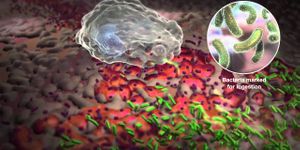Videos
Scientists Replicate Alzheimer's In Petri Dish
OCT 13, 2014 12:00 AM PDT
Share
Material, Heal Thyself
 Imagine all of the money, bother, and time that would be saved if materials such as asphalt, concrete, and metals could heal themselves? As strange as it seems, it is in the realm of possibility. For example, Dr. Erik Schlangen, a civil engineer at Delft University in The Netherlands has come up with an asphalt that contains strands of steel wool mixed in, so that with some help, it can meld itself back together if it is broken up. He demonstrated this process at a TED talk, where he broke a piece of asphalt in two, put the pieces back together and heated them in an industrial microwave oven. When he took it out and let it cool a bit, the pieces were one again. The microwave heated the steel wool, melting the bitumen in the asphalt, knitting the material back together. But, you can't put a road in a microwave oven, so how do you apply this process in the field? Schlangen has developed a vehicle that heats the road by passing induction coils over it. He estimates that if the road was repaired this way every four years or so its life could be doubled. The Dutch government has given him some road to test his asphalt on and so far the results have been good.
Imagine all of the money, bother, and time that would be saved if materials such as asphalt, concrete, and metals could heal themselves? As strange as it seems, it is in the realm of possibility. For example, Dr. Erik Schlangen, a civil engineer at Delft University in The Netherlands has come up with an asphalt that contains strands of steel wool mixed in, so that with some help, it can meld itself back together if it is broken up. He demonstrated this process at a TED talk, where he broke a piece of asphalt in two, put the pieces back together and heated them in an industrial microwave oven. When he took it out and let it cool a bit, the pieces were one again. The microwave heated the steel wool, melting the bitumen in the asphalt, knitting the material back together. But, you can't put a road in a microwave oven, so how do you apply this process in the field? Schlangen has developed a vehicle that heats the road by passing induction coils over it. He estimates that if the road was repaired this way every four years or so its life could be doubled. The Dutch government has given him some road to test his asphalt on and so far the results have been good.Concrete is the most common construction material in the world, and while it is very versatile and strong, it's subject to developing cracks, which can grow worse with time as they are continually infiltrated with water or ice. A strange solution to this problem is to put bacteria in the concrete. Yes, bacteria. With this method, bacterial spores in tiny water-permeable capsules are added during the concrete's manufacture. Then the concrete is used as normal and the spores remain inert until water seeps in, causing them to germinate and move toward the surface of the water. As they do, they produce calcite, which fills in the cracks as the bacteria move. Researchers all over the world are looking at this approach, including those at the University of Illinois in the U.S., the University of Ghent in Belgium, Cardiff University in the U.K. and Delft University in the Netherlands. If this type of self-healing concrete is deemed viable, it is likely to be an expensive option and used sparingly. In an interview with The Atlantic's CityLab website, Steve Kosmatka, Vice President of Research and Technical Services at the Portland Cement Association says it is, "Not for sidewalks or roads right in front of houses, but for a bridge you want to get a hundred years out of."
What about metal? There's potential for self-healing there, too. MIT researchers recently found something so surprising that they thought it was a mistake. Under certain circumstances exerting a force on a metal that would be expected to pull it apart had the opposite effect - it caused the crack to close and fuse together. "We had to go back and check," said professor of materials science and engineering Michael Demkowicz, when "instead of extending, [the crack] was closing up. First, we figured out that, indeed, nothing was wrong. The next question was: ‘Why is this happening?" The answer turned out to lie in how grain boundaries interact with cracks in the crystalline microstructure of metal. Grain boundaries are the tiny grains that make up the structure of a metal. It was found that under certain conditions stress causes the microstructure to change, making the grain boundaries migrate, leading to closing the crack.
This discovery is very new and still quite far away from practical application. But, the researchers plan to study how to design metal alloys so cracks would heal under loads typical for particular applications. Since techniques for controlling the microstructure of alloys already exists, Demkowicz says they just have to figure out how to achieve the desired result.
All of these self-healing materials could, of course, result in huge savings in maintenance costs. But another benefit is environmental in nature. If the things that they are used in have longer life spans, they will have to be replaced less often, resulting in a reduction in a reduction in resources used and any pollutants caused in their creation.
You May Also Like
Loading Comments...








